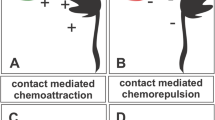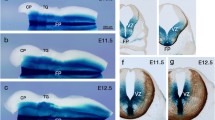Abstract
The floor plate of the neural tube is of major importance in determining axonal behaviour, such that, having crossed, decussating axons do not cross back again. The ventral commissure (VC) of the spinal cord forms immediately ventral to the floor plate shortly after neural tube closure. It is the principal location in which decussating axons cross the midline. It is probably also of major importance in neural tube development, but has received relatively little attention. This study analyses the growth and development of the rat VC and also axon-glial relationships within it throughout the crucial prenatal period of extensive transmedian axon growth, when key biochemical interactions between the two tissues are taking place. The morphometric, stereological and immunohistochemical methods used show that the axonal and glial populations remain in a finely balanced equilibrium throughout a period of almost a hundred-fold growth of both elements. At all stages axons are highly segregated into small bundles of constant size by glial processes, to which they are closely apposed. Thus, glial-axon contact is remarkably precocious, uniquely intimate and persists throughout VC development. This suggests that the relationship between the two tissues is highly controlled through interactions between them. The VC is likely to be the physical basis of a second set of glial-axonal interactions, namely, those which are well known to influence axon crossing behaviour. In mediating these, the extensive axon-glial contact is an ideal arrangement for molecular transfer between them, and is probably the substrate for altering axon responsiveness and ensuring reliable transmedian decussation. The VC is therefore a segregating matrix temporally and spatially specialised for a range of key developmental axon-glial interactions.
Similar content being viewed by others
References
ALTMAN, J. & BAYER, S. A. (1984) The Development of the Rat Spinal Cord. Berlin: Springer-Verlag.
BROSE, K., BLAND, K. S., WANG, K. H, ARNOTT D., HENZEL, W., GOODMAN, C. S., TESSIER-LAVIGNE, M. & KIDD, T. (1999) Slit proteins bind Robo receptors and have an evolutionarily conserved role in repulsive axon guidance. Cell 96, 795–806.
BROSE, K. & TESSIER-LAVIGNE, M. (2000) Slit proteins: Key regulators of axon guidance, axonal branching, and cell migration. Current Opinion in Neurobiology 10, 95–102.
CAMPBELL, R. M. & PETERSON, A. C. (1993) Expression of a lacZ transgene reveals floor plate cell morphology and macromolecular transfer to commissural axons. Development 119, 1217–1228.
COLAMARINO, S. A. & TESSIER-LAVIGNE, M. (1995) The role of the floor plate in axon guidance. Annual Review of Neuroscience 18, 497–529.
DODD, J., MORTON, S. B., KARAGOGEOS, D., YAMAMOTO, M. & JESSELL, T. M. (1988) Spatial regulation of axonal glycoprotein expression on subsets of embryonic spinal neurons. Neuron 1, 105–116.
FRAHER, J. P. (1992) The CNS-PNS transitional zone of the rat: Morphometric studies at cranial and spinal levels. Progress in Neurobiology 3, 261–316.
FRAHER, J. P. (1997) Axon-glial relationships in early CNS-PNS transitional zone development: An ultrastructural study. Journal of Neurocytology 26, 41– 52.
FRAHER, J. P. (1999) The transitional zone and CNS regeneration. Journal of Anatomy 194, 161–182.
FRAHER, J. P. & KAAR, G. F. (1986) The lumbar ventral root-spinal cord transitional zone in the rat. A morphological study during development and at maturity. Journal of Anatomy 145, 109–122.
GALKO, M. J. & TESSIER-LAVIGNE, M. (2000) Biochemical characterisation of netrin-synergising activity. Journal of Biological Chemistry 75, 7832–7838.
GORGELS, T. G. (1991) Outgrowth of the pyramidal tract in the rat cervical spinal cord: Growth cone ultrastructure and guidance. Journal of Comparative Neurology 306, 95–116.
GUNDERSEN, H. J. G. & JENSEN, E. B. (1987) The efficiency of systematic sampling in stereology and its prediction. Journal of Microscopy 147, 229–263.
HARRIS, H. A. & HOLT, C. E. (1999) Slit, the midline repellent. Nature 398, 462–463.
HARRIS, R., SABATELLI, L. M. & SEEGER, M. A. (1996) Guidance cues at the Drosophila CNS midline: Identification and characterisation of two Drosophila Netrin/ UNC-6 homologs. Neuron 17, 217–228.
IMONDI, R., WIDEMAN, C. & KAPRIELIAN, Z. (2000) Complementary expression of transmembrane ephrins and their receptors in the mouse spinal cord: A possible role in constraining the orientation of longitudinally projecting axons. Development 127, 1397–1410.
KAAR, G. F. & FRAHER, J. P. (1986) The sheaths surrounding the attachments of rat lumbar ventral roots to the spinal cord: A light and electron microscopical study. Journal of Anatomy 148, 137–146.
KENNEDY, T. E., SERAFINI, T., DE LA TORE, J. R. & TESSIER-LAVIGNE, M. (1994) Netrins are diffusible chemotropic factors for commissural axons in the embryonic spinal cord. Cell 78, 425–435.
KIDD, T., RUSSELL, C., GOODMAN, C. S. & TEAR, G. (1998) Dosage-sensitive and complementary functions of roundabout and commissureless control axon crossing of the CNS midline. Neuron 20, 25–33.
MARTINI, R. & SCHACHNER, M. (1988) Immunoelectron microscopic localisation of neural cell adhesion molecules (L1, NCAM and MAG) in regenerating adult mouse sciatic nerve. Journal of Cell Biology 106, 1735– 1746.
MATISE, M. P., LUSTIG, M., SAKURAI, T., GRUMET, M. & JOYNER, A. L. (1999) Ventral midline cells are required for the local control of commissural axon guidance in the mouse spinal cord. Development 126, 3649–3659.
MAYHEW, T. M. (1992) A review of recent advances in stereology for quantifying neural structure. Journal of Neurocytology 21, 313–328.
MURAKAMI, F. & SHIRASAKI, R. (1997) Guidance of circumferentially growing axons by the floor plate in the vertebrate central nervous system. Cell and Tissue Research 290, 323–330.
O’BRIEN, D., DOCKERY, P., McDERMOTT, K. & FRAHER, J. P. (1998) The ventral motoneurone axon bundle in the CNS–-A cordone system? Journal of Neurocytology 27, 247–258.
O’BRIEN, D., DOCKERY, P., McDERMOTT, K. & FRAHER, J. P. (2001) Early development of the rat ventral root transitional zone: An immunohistochemical and morphometric study. Journal of Neurocytology 30, 11– 20.
RATHJEN, F. G. & JESSELL, T. M. (1991) Glycoproteins that regulate growth and guidance of vertebrate axons: Domains and dynamics of the immunoglobulin/fibronectin type III subfamily. Seminars in Neuroscience 3, 297–307.
SCHUBERT, W., COSKUN, V., TAHMINA, M., RAO, M. S., LUSKIN, M. B. & KAPRIELIAN, Z. (2000) Characterization and distribution of a new cell surface marker of neuronal precursors. Developmental Neuroscience 22, 154–166.
STOECKLI, E. T. & LANDMESSER, L. T. (1995) Axonin-1, Nr-CAM, and Ng-CAM play different roles in the in vivo guidance of chick commissural neurons. Neuron 14, 1165–1179.
TEAR, G., HARRIS, R., SUTARIA, S., KILOMANSKI, K., GOODMAN, C. S. & SEEGER, M. A. (1996) Commissureless controls growth cone guidance across the CNS midline in Drosophila and encodes a novel membrane protein. Neuron 16, 501–514.
Towe, A. L. & Harding, G. W. (1985) Pattern of myelination in the pyramidal tract of the rat. Exp. Neurol 89, 284–288.
VALENTINO, K. L., JONES, E. G. & KANE, S. A. (1983) Expression of GFAP immunoreactivity during development of long fiber tracts in the rat CNS. Brain Research 285, 317–336.
WEIBEL, E. R. (1979) Stereological Methods, Vol. 1: Practical Methods for Biological Morphometry. London: Academic Press.
WILLIAMS, M. A. (1977) Quantitative methods in biology. In Practical Methods in Electron Microscopy (edited by GLAUERT, A. M.) pp. 36–38. Amsterdam: North Holland Publishing Company.
Author information
Authors and Affiliations
Corresponding author
Rights and permissions
About this article
Cite this article
Lane, S., McDermott, K., Dockery, P. et al. The developing cervical spinal ventral commissure of the rat: A highly controlled axon-glial system. J Neurocytol 33, 489–501 (2004). https://doi.org/10.1007/s11068-004-0512-x
Received:
Revised:
Accepted:
Issue Date:
DOI: https://doi.org/10.1007/s11068-004-0512-x




